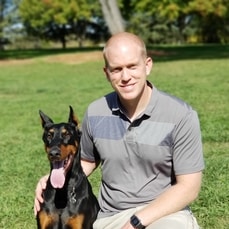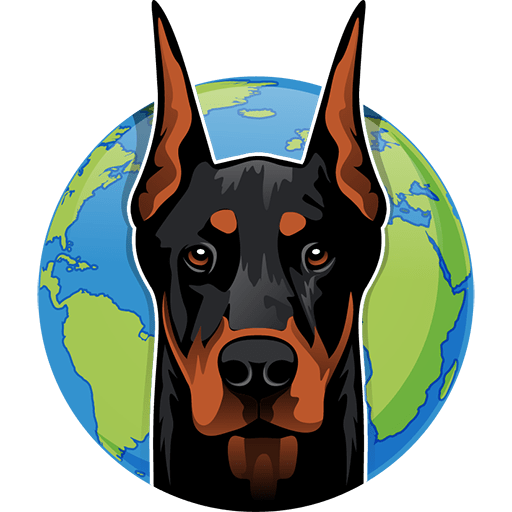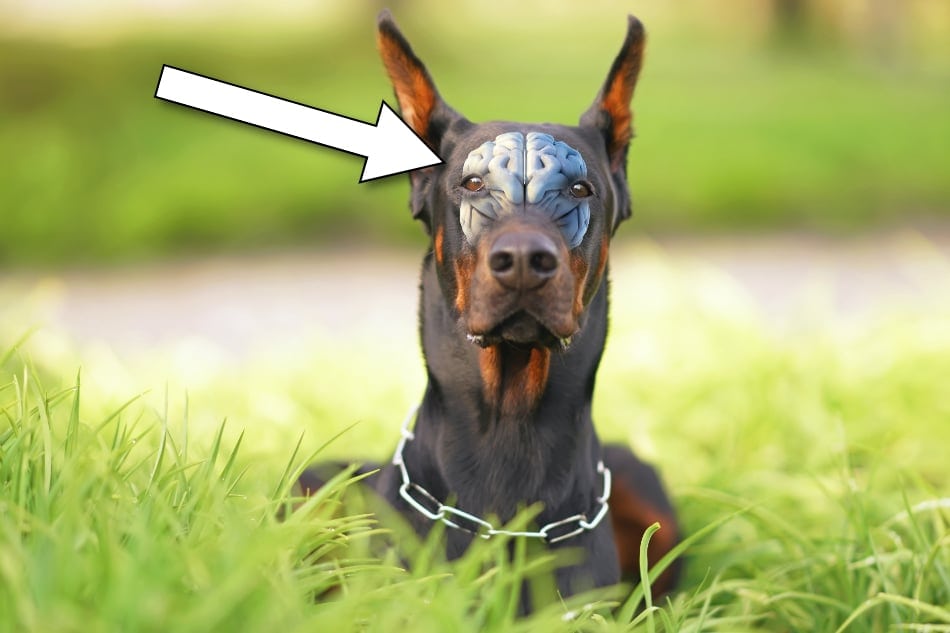
There is a common myth about Dobermans that says they will randomly turn on their owners without provocation. It’s said that due to the Doberman’s small skull size and their continuously growing brain, eventually, the brain will become too large for the skull and it’ll cause a sudden burst of aggression that’s directly primarily towards their owners.
Do Dobermans turn on their owners? No, Dobermans do not turn on their owners. They are the only breed ever created for the personal protection of their owners and are extremely loyal. They are not known for sudden acts of aggression towards their masters.
Doberman Pinschers are a naturally protective breed. They are no more prone to turn on their masters than any dog originally bred as a guard dog. John T. Brueggeman of the Doberman Pinscher Club of America states they are more loyal and trustworthy to their owners than most other breeds (source).
Throughout my years of working with the Doberman breed, I’ve yet to find a case of aggression that did not have an explanation involving the dog’s past treatment or physical health.
Why Dobermans Do Not Turn on Their Masters
Dobermans possess a long list of behavior traits that run contrary to the belief that they are prone to turning on their masters. Some of these traits are:
- Highly Intelligent – Dobermans are extremely intelligent. Intelligent dogs don’t generally have as many problems with impulse control as dogs of lower intelligence levels do. They have a strong cognitive ability to think before they act. Dobermans are one of the top five smartest dogs according to PetMD. Their high level of intelligence makes them easy to train and allows them to easily adhere to rules and boundaries their owners have set.
- Loyal – Dobermans are known to be extremely loyal dogs. A dog who has naturally loyal tendencies will bond with and protect their families, not suddenly become aggressive towards them. They do have a tendency to bond more with one particular family member, but they also protect their “pack” as a whole. This single-person bond is stronger in female Dobermans than males, however. You can read more about the differences between male and female Dobermans here.
- People-Oriented – Dobermans are people-oriented dogs. If you’ve ever had an up-close interaction with a Doberman, you may notice that he or she will look directly into your eyes while you’re talking to them. They are highly in-tune with your body language and emotions. Dogs that display these qualities rarely have aggression issues towards their owners or families.
- Loving – Love and affection are a priority for Dobermans. This is likely related to their role as a personal guardian. They are often referred to as “velcro dogs” because once they bond with you, they will stick to your side. Dogs who behave like this are far more likely to protect their owners than harm them.
- Protective – These are highly protective dogs. Dogs that have the natural instincts to be protective of their “pack” (or family) as the Doberman does are less likely to harm their owners. A case could be made that they may be more prone to take physical action against a threatening stranger, but not against their own masters.
The Brain Size vs. Skull Size Myth
The most common myth about why a Doberman might “go crazy” and turn on their owner has to do with their brain growing too big for their small skulls. While it’s true that Dobermans have a smaller head size as compared to their body size than many other breeds, no breed of dog in existence has been known to possess a skull that is physically too small for its brain.
However, there is a serious health condition called syringomyelia, which causes fluid to build up near the top of the spine (or base of the brain) in dogs. This primarily affects Cavalier King Charles Spaniels (source). The earliest symptoms of this are neck pain and discomfort. As it progresses it can lead to timidness, shyness, and touch aversion. However, this is not known to affect Dobermans.
There are no scientific studies currently that suggest any type of unusual brain function in Dobermans is a result of too large of a brain as it relates to the size of their skulls. While their brains and skulls are smaller than other breeds their size, their intelligence level is higher than most and are commonly cited as being among the top 5 most intelligent dog breeds in the world.
There are some possible explanations for this myth however that may be at least partially rooted in fact. These have to do with two other conditions Dobermans can suffer from which may be responsible for feeding into this myth.
One is a behavioral condition called Canine Compulsive Disorder (or CCD) and another is a medical condition called hypothyroidism. Dobermans are prone to both of these.
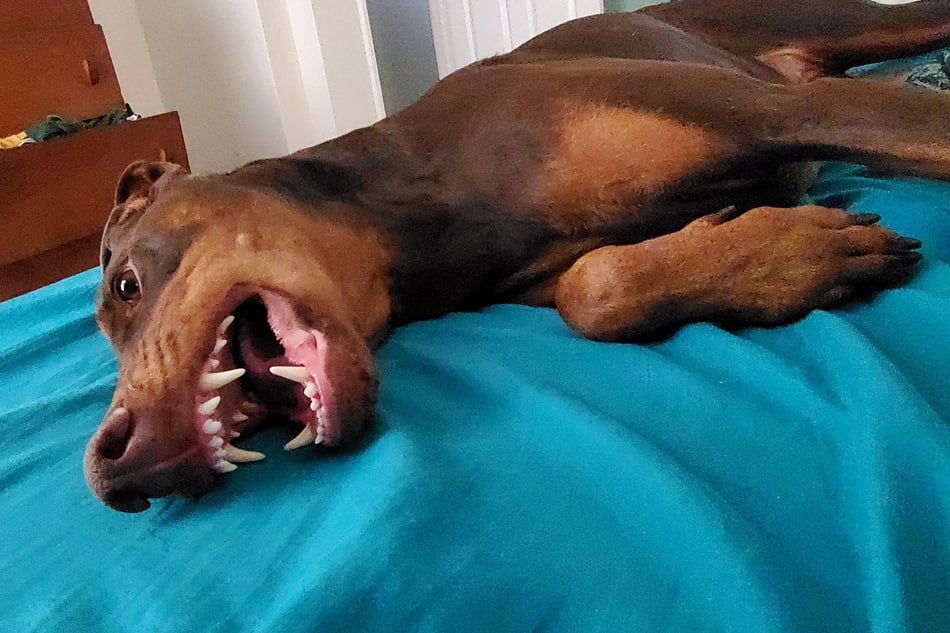
Canine Compulsive Disorder (or CCD)
As many as 28% of Dobermans may be affected by canine compulsive disorder, or CCD (source). This is also often called compulsive behavior disorder and may be at least partially to blame for this myth. This is the only disorder in Dobermans that may have some relation to the dog’s brain size. This disorder is similar to obsessive-compulsive disorder (OCD) in humans.
A dog affected by this disorder will often perform repetitive behaviors that appear to have no purpose to the extent that it interferes with their normal life. In Dobermans, this is usually behaviors such as compulsive licking and sucking on the flank area of the skin. The “flank” of the dog is the two thin stretches of skin connecting the rear legs to the bottom of the torso of the dog. You can learn more about the symptoms of CCD in this article by WebMD.
On rare occasions, Dobermans affected by CCD will show some self-directed aggression issues such as attacking their own legs or tail. However, they have not been known to display aggression towards others due to CCD and no studies to date suggest this correlation.
Although this behavior disorder is usually related to anxiety and stress in the dog, there was one study that showed a correlation between the brain’s volume and density in certain areas and the development of CCD (source). For this reason, it’s possible that this condition may have fueled the myth of Dobermans developing cognitive issues due to brain size.
Hypothyroidism
The second possible explanation for this myth may have to do with hypothyroidism, a medical condition that the Doberman breed, along with many other breeds, is prone to.
This condition occurs with the thyroid gland is not producing enough thyroid hormone, causing a hormone imbalance. This typically develops in middle-aged dogs between 4 and 10 years of age. The symptoms can include weight gain, hair loss, exercise intolerance, decreased appetite, and behavior problems.
The interesting thing here is typically the behavior problems with this disorder are noticeable before the physical symptoms are (source).
The behavior problems associated with hypothyroidism in Dobermans often start with behaviors appearing similar to CCD (as described in the previous section) but can develop into shyness, anxiety, or fear.
“This abnormal behavior can be intermittent and erratic, escalating to aggression.”
– W. Jean Dodds, DVM, of Hemopet in Southern California
It is possible for dogs suffering from untreated hypothyroidism to become aggressive to the point that their owners feel they need to surrender their dog to rescue centers or shelters.
There was one paper published titled “The Effect of Hypothyroid Function on Canine Behavior” by Drs. Linda P. Aronson and W. Jean Dodds, which did show a “highly statistically significant relationship between thyroid dysfunction and dog-to-human aggression.” It also showed a relationship with dog on dog aggression as well (source).
However, hypothyroidism is very treatable in Dobermans and usually involves the use of a prescription medication that will replace the missing thyroid hormone in the dog. Again, this is a common health issue in many breeds of dogs and is not exclusive to the Doberman.
This condition may also be at least partially responsible for the myth of a Doberman’s sudden aggression towards their owners.
To learn more about the health issues common to the Doberman breed, see my article The Doberman Pinscher: A Complete Breed Overview.
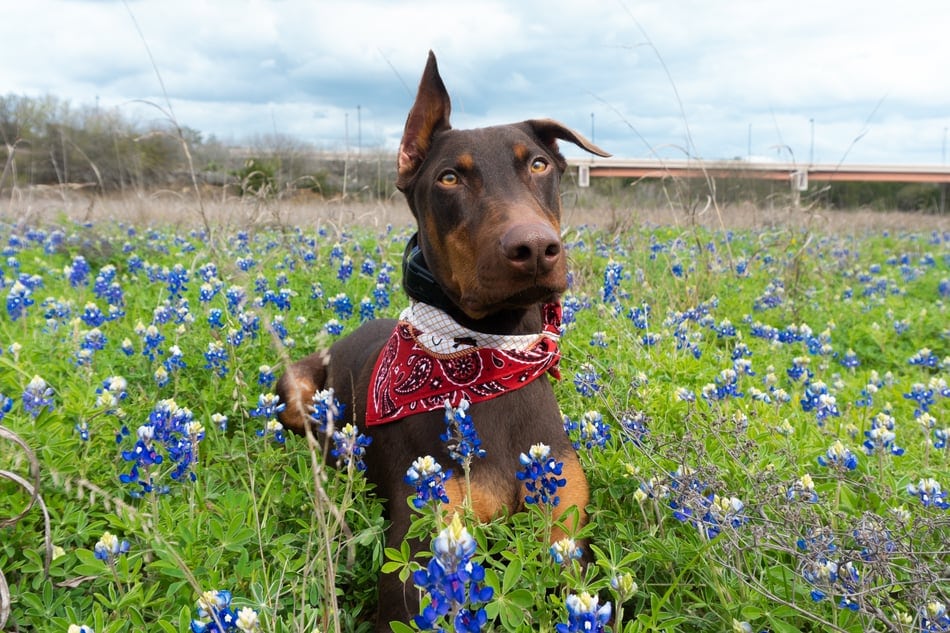
Doberman Dog Bite Statistics
According to a study done on dog bite fatalities as reported to the Centers for Disease Control and Prevention, during a 13 year period between 2005 and 2017, there were a total of 433 people killed from dog bites in the United States. Of those, only 6 deaths were attributed to Dobermans, or about 1.4%.
This study indicated that Dobermans were 11th most responsible breed for these fatalities. More fatalities from dog bites were attributed to Labrador retrievers and huskys than were to Dobermans.
| Breed | Deaths | Percent of Total |
|---|---|---|
| Pit bull | 284 | 65.6% |
| Rottweiler | 45 | 10.4% |
| German shepherd | 20 | 4.6% |
| American bulldog | 15 | 3.5% |
| Mastiff (including bullmastiff) | 14 | 3.2% |
| Husky | 13 | 3% |
| Labrador retriever | 9 | 2.1% |
| Boxer | 7 | 1.6% |
| Doberman pinscher | 6 | 1.4% |
For a full breakdown of these statistics, including sources. Please see Dogsbite.org: U.S. Dog Bite Fatalities (2005 to 2017).
I dive further into these statistics, and the overall instincts of the Doberman as it comes to aggression in my article Are Dobermans Mean, Dangerous, or Overly Aggressive?
Max Sparwasser Law Firm published the statistics relating to significant injury or death from dog bites based on media reports. The statistics were listed by breed from 1982 to 2014. Dobermans appeared 18th on the list of the top 30 breeds of dogs causing serious injuries (source).
According to the American Veterinary Medical Association, half of the injuries resulting from dog bites are on children between the ages of 5 and 9 years old. The top three people most bitten were kids, the elderly, and postal service employees.
It’s clear from these statistics that Dobermans are not generally prone to turning on, and injuring, their owners. While it’s clear the statistics don’t back up this myth, Doberman attacks can still happen (just like with any breed). So let’s talk about reasons they might occur with a Doberman.
Why Doberman Attacks Happen
When Dobermans are properly trained and socialized, the chances of anyone getting bitten is really quite slim. However, these are situations where a bite could occur.
You’ll note that many of these are triggers for most dog breeds and are not specific to just Dobermans.
- Food Aggression. Dobermans, like most dogs, are very protective of their food. This is a survival instinct most dogs have that was passed down from their wild ancestors. If someone approaches a Doberman and there is any fear about sharing or having the food stolen, this could be the cause of aggression if the dog hasn’t been trained properly.
- Dominance Aggression. Dobermans are dominant dogs and it’s well known in the Doberman world that this can lead to issues with other dogs. Same-sex aggression can be an issue with Dobermans because of this. However, dominance issues rarely lead to anything more serious than a small nip with humans.
- Fear Aggression. Since Dobermans are bred for guarding and protection of a family, if they become startled or surprised, this could lead to fear-based biting. This is usually easily prevented however with proper socialization early in the dog’s life.
- Predatory Aggression. Dobermans have a high prey drive so it’s a natural instinct for them to give chase, especially with small furry animals. Small animals and children should be watched carefully around your Doberman when they’re young and still learning what’s expected of them.
- Territorial Aggression. These dogs are well aware of the physical boundaries of their home and they can be extra protective while on their own property. This is an instinct that is generally directed towards strangers who may come onto your property and is almost never a concern of anyone within the immediate family.
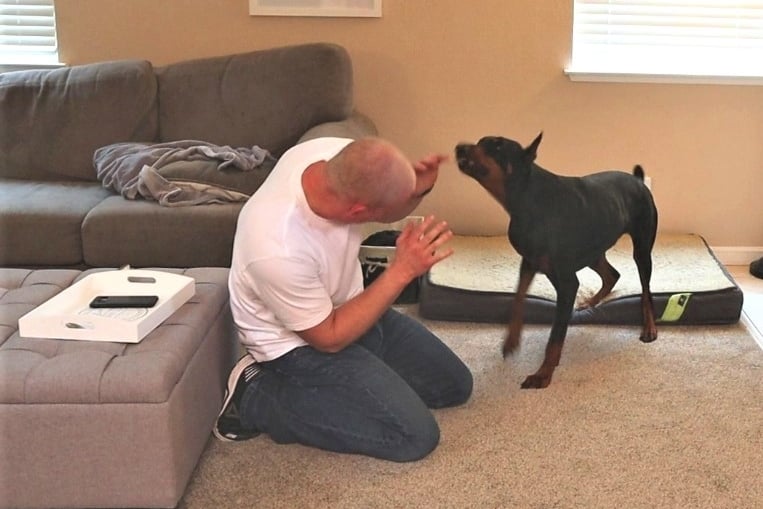
Warning Signs That Your Doberman Might Be About to Bite
Dobermans are not prone to biting out of the blue. There are almost always warning signs that can predict aggressive behavior. You’ll probably easily notice if he is displaying signs of distress.
These are some of the more common signs that your Doberman may be uncomfortable, anxious, suspicious of a given situation, or even about to bite.
- Avoiding eye contact. This is especially the case if the dog is pacing around back and forth near, but slightly out of reach, of someone they just met. This is most often associated with fear and can be a sign of the potential for fear biting.
- Maintaining eye contact while not moving. Maintaining eye contact with someone they are suspicious of is also a common sign in Dobermans. This isn’t generally a sign of fear like the previous point, but of suspicion. These dogs love eye contact naturally but this could be a cause for concern especially when the dog has a motionless body and is intently following the subject with their eyes.
- Licking lips. This can be an early sign that your Doberman may be uncomfortable. This doesn’t mean he is going to bite, but it does mean he is unsettled and anxious.
- Showing teeth, growling, or snapping. This is a much more obvious sign your Doberman is uncomfortable and it’s usually meant as a “final warning.”
- Rigid body. If your dog is on edge, every muscle will stiffen and you’ll notice they will slightly transfer more of their weight to their front two feet. You will see him standing very squarely towards their target with ears perked. They almost appear frozen. If your dog is exhibiting this body posture, it’s another sign that he is very uncomfortable with a situation.
- Hackles raised. If the ridge of hair along your Doberman’s spine (called the “hackles”) is raised, he is definitely on edge. The fur on the neck or back will raise when a dog feels threatened. On Dobermans, this is most noticeable high on the back near the shoulder blades.
Things That Tend to Trigger a Doberman
How your Doberman was raised and socialized is probably the biggest factor in determining how likely they are to get triggered by any specific circumstance. If your dog came from a shelter or had any abuse in his or her background, their trigger may be “pulled” a bit more quickly than other dogs who were raised in more nurturing environments.
If your Doberman was raised in your home and feels safe and comfortable in almost any situation, there will be little that will unsettle him to the point of biting. You’d be amazed how tolerant a well-raised Doberman can be of just about any situation as an adult.
However, there are situations that will make any dog uncomfortable but depending on your dog’s background, the reactions will vary. Be aware of a situation that may create tension for your Doberman such as the following.
- Feeling the need to defend territory or a family member.
- Being startled, suddenly woken up, or approached quickly from behind.
- Having someone approach when they are already fearful.
- Injury or illness.
- Physical abuse or punishment.
The Importance of Proper Training and Socialization
A Doberman that has been well socialized and has proven itself over time can be an amazingly gentle, loving, and steadfast dog that can be fully trusted with infants and adults alike. In fact, Dobermans are known for being extremely good with kids.
Making sure to socialize your dog as much as possible during their first year of life will help them to become predictable as adults later on.
Expose your dog to as many situations, noises, other animals, other dogs, and people as possible early and often. Then just give your dog plenty of love. These are the absolute best things you can do to promote the development of a gentle adult Doberman.
When their boundaries have been well defined and expectations made clear, they will generally be more than happy to comply. You’ll never have to worry about your dog turning on you, especially if that dog is a Doberman.
Final Thoughts
While the myth that a Doberman will randomly turn on, and attack, its owner is a long-standing one. Hopefully, it’s clear now that this is a myth and nothing more. The statistics and anecdotal evidence of almost all Doberman owners I have spoken to simply don’t support this conclusion.
Many Doberman owners every year come to me with behavior problems of various kinds and levels of seriousness. I have yet to see one case of a Doberman who wasn’t abused or otherwise mistreated, turning on their owner. It just doesn’t happen in the Doberman world in my experience.
This may be just the result of rumors started based on quarter truths from other medical conditions such as CCD and Hypothyroidism, but it’s certainly not based on scientific evidence that their brains swell to a size that’s too large for their skulls—that’s simply a tall tale.
Just keep loving your Dobermans and they will return the favor every day. That’s why this breed makes an amazing family dog. See my article Are Dobermans Good Family Dogs? The Surprising Truth for more.
TIP: Are you considering getting a Doberman puppy? Take a look at my article 15 Places to Find Doberman Puppies for Sale: Best to Worst for a list of some great sources for Doberman puppies!
Related Questions
Do Dobermans become suddenly aggressive? Dobermans are smart, loyal, and obedient dogs. A Doberman raised properly in a loving home will not become suddenly aggressive without provocation.
Can a Doberman kill you? Most large dog breeds are capable of killing a human. However, Dobermans have only been involved in 1.4% of human fatalities over a 13-year period, per the Centers for Disease Control. Despite being bred for use in protection rolls, Dobermans are rarely involved in human fatalities.
Helpful Resources
- 9 Proven Ways to Bond with a Doberman of Any Age – We know Dobermans are one of the most loyal dog breeds in the world but if you place a little extra focus into building your bond with your Doberman, you’d be amazed how far that can go. Having a deep bond with your Dobie makes command training, behavior training, and just daily life with your dog so much better.

